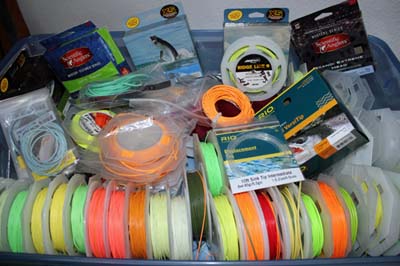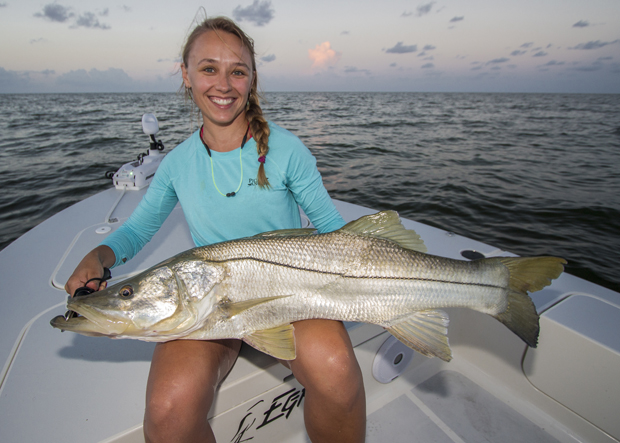A lesson learned
[dropcap]I[/dropcap]t was my first day and early morning on Mexico’s Ascension Bay. My guide was Jorge Sanchez, a local independent with a Caribbean style skiff that was pushed by an ancient 60 Yamaha. It could fly!
Within 30 minutes he’d put me on a snook that was lazily cruising near the surface in murky water, a few feet in front of, and parallel to a thick overhanging of flora bordering a mangrove jungle that ran for miles along the coast – broken occasionally by narrow, meandering rivers that ran inland.
We were slightly ahead of undecimalis, and about 60- to 65-feet from it. The wind was blowing 15 in our faces. There was only 50 yards of mangrove wind protection left before we’d hit open water and Jorge said we’d be facing, literally, a blow of 25 or more.
I cast for an intercept, but the wind took the fly from it’s intended arrival to well behind and short. My adjusted cast was perfect, but admittedly very lucky. I started two hand stripping and “bam” fish on. I made the mistake of high sticking, but got lucky and the snook stayed on. Reorganized, I kept it from it’s bee-line track back to the mangroves, turned it and gained some line back. Head shakes galore and mini jumps by the dozens and I re-lost claimed line, but Jorge had motored us out, away from a possible mangrove entanglement.
 “Esto es un pescado enorme.” Jorge said. I replied, ¿cómo grande? Jorge said, “Si, estimación 13- 14- kilos” (27 to 33-pounds). WOW, that’s the biggest snook I’ve ever seen, I said to myself. Adding out loud, The biggest I’d ever caught was about 10-pounds in Everglades National Park. Jorge didn’t understand, but said si anyway.
“Esto es un pescado enorme.” Jorge said. I replied, ¿cómo grande? Jorge said, “Si, estimación 13- 14- kilos” (27 to 33-pounds). WOW, that’s the biggest snook I’ve ever seen, I said to myself. Adding out loud, The biggest I’d ever caught was about 10-pounds in Everglades National Park. Jorge didn’t understand, but said si anyway.
I was under-gunned. I had a fast action 7-weight (we were going for bones) with 8-weight floating fly line, and rigged according to IGFA rules at 16-pound test class tippet with no bite guard. I needed at least a ‘9’ or ‘10’ and a shock-tippet of at least 30-pound test.
I had been reeling in fly line and, unbeknownst to me, some of it was on the seat I was using as my casting and fighting deck. One quick, unexpected burst while inches away from Jorge’s grasp and snap. I was standing on the fly line with boat shoes. The leader broke off just above the eye of the hook.
In warm weather or tropical climates fish shoeless. You’ll feel the fly line should it end up under foot. Wearing shoes? Fuhgeddaboudit.
A basket, bucket, mat or hands?
On a skiff you have the pleasure of choosing a bucket, mat or skiff deck to help you manage fly line. Ashore, it’s the basket, or Joe Mahler’s technique – no basket . . . An adaptation that takes a little practice but sure beats carrying a basket around.
You can, of course, ignore everything and succeed in destroying an $80 line in one afternoon – dragging it over debris and yanking it from entanglements.
Fly lines can see
Fly lines, it turns out, have a built-in mechanism, installed by the Russians, that while you’re not looking (it knows that too), look around (yes it can see) for any cast-obstructing objects it can find. These spy fly lines are inventive; they can find shoelaces, toes, pants, belts, shirt buttons, a reel in the gunnel rod holder, fit underneath anything on deck, go overboard and then wrap around the propeller shaft. However, underfoot is its best and preferred move.
Fixes
Problem: Tangle
Solution: Clean your fly line. You’ll be amazed at how little chance your line has to tangle when slick. Don’t necessarily clean on every outing – more like when noticeably dirty or starting to tangle. Salt marsh fishing and pond scum will gum up fly lines quickly.
Problem: Fly line memory
Solution: Cast line out so that it’s all on the water, then drag it behind the boat for just a few minutes. Then reel it in and plop it on the deck. You’ll then be pulling line from the top not the bottom of the pile. When you pull line off the reel onto the deck or into a bucket, you’ll be pulling line from the bottom of the pile first, and snarls will happen.
If on land, strip and tug the line in sections that are arms length. Stretch one section at a time.
Large arbor reels have the same line memory problems as smaller diameter reels.
[information]
Snook (Centropomus undecimalis). The common snook is a species of marine fish in the family Centropomidae of the order Perciformes. This species is native to the coastal waters of the western Atlantic Ocean and Caribbean Sea, from southern Florida and Texas to Rio de Janeiro
[/information]


